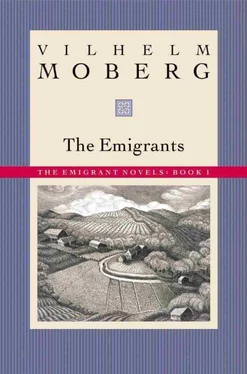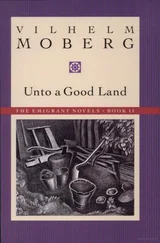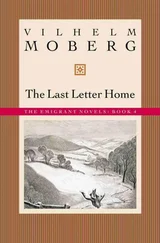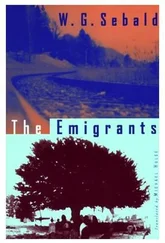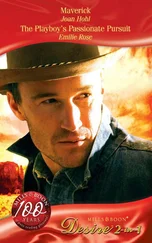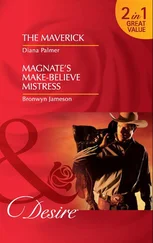Vilhelm Moberg - The Emigrants
Здесь есть возможность читать онлайн «Vilhelm Moberg - The Emigrants» весь текст электронной книги совершенно бесплатно (целиком полную версию без сокращений). В некоторых случаях можно слушать аудио, скачать через торрент в формате fb2 и присутствует краткое содержание. Год выпуска: 1995, Издательство: Minnesota Historical Society Press, Жанр: Классическая проза, на английском языке. Описание произведения, (предисловие) а так же отзывы посетителей доступны на портале библиотеки ЛибКат.
- Название:The Emigrants
- Автор:
- Издательство:Minnesota Historical Society Press
- Жанр:
- Год:1995
- ISBN:нет данных
- Рейтинг книги:3 / 5. Голосов: 1
-
Избранное:Добавить в избранное
- Отзывы:
-
Ваша оценка:
- 60
- 1
- 2
- 3
- 4
- 5
The Emigrants: краткое содержание, описание и аннотация
Предлагаем к чтению аннотацию, описание, краткое содержание или предисловие (зависит от того, что написал сам автор книги «The Emigrants»). Если вы не нашли необходимую информацию о книге — напишите в комментариях, мы постараемся отыскать её.
The Emigrants — читать онлайн бесплатно полную книгу (весь текст) целиком
Ниже представлен текст книги, разбитый по страницам. Система сохранения места последней прочитанной страницы, позволяет с удобством читать онлайн бесплатно книгу «The Emigrants», без необходимости каждый раз заново искать на чём Вы остановились. Поставьте закладку, и сможете в любой момент перейти на страницу, на которой закончили чтение.
Интервал:
Закладка:
And so it was, down through the years, through the path of generations, down through centuries.
About the middle of the nineteenth century, however, the order of unchangeableness was shaken to its very foundations. Newly discovered powers came into use, wagons moved without horses, ships without sails, and distant parts of the globe were brought closer together. And to a new generation, able to read, came the printed word with tales of a land far away, a land which emerged from the mists of the saga and took on the clearing, tempting aspects of reality.
The new land had soil without tillers and called for tillers without soil. It opened invitingly for those who longed for a freedom denied them at home. The urge to emigrate stirred in the landless, in the debt-bound, the suppressed and the discontented. Others again saw no mirage of special privilege or wealth in the new land, but wanted to escape entanglements and dilemmas in the old country. They emigrated, not to something but from something. Many, and widely different, were the answers to the question: Why?
In every community there were some men and women who obeyed the call and undertook the uncertain move to another continent. The enterprising made the decision, the bold were the first to break away. The courageous were the first to undertake the forbidding voyage across the great ocean. The discontented, as well as the aggressive, not reconciling themselves to their lot at home, were emigrants from their home communities. Those who stayed — the tardy and the unimaginative — called the emigrants daredevils.
The first emigrants knew little of the country awaiting them, and they could not know that more than a million people would follow them from the homeland. They could not foresee that, a hundred years hence, one-fourth of their own people were to inhabit the new country; that their descendants were to cultivate a greater expanse of land than the whole arable part of Sweden at that time. They could not guess that a cultivated land greater than their whole country would be the result of this undertaking — a groping, daring undertaking, censured, ridiculed by the ones at home, begun under a cloud of uncertainty, with the appearance of foolhardiness.
Those men and women, whose story this is, have long ago quitted life. A few of their names can still be read on crumbling tombstones, erected thousands of miles from the place of their birth.
At home, their names are forgotten — their adventures will soon belong to the saga and the legend.
The Country Which They Left
The Parish
Ljuder Parish in Konga County is about twelve miles long and three miles wide. The soil is black loam, interspersed with sandy mold. Only smaller bodies of water exist — two brooks and four lakes or tarns. Dense pine forests still remained a hundred years ago, and groves of deciduous trees and thickets spread over wide areas which now are used as pasture.
On January 1, 1846, Ljuder Parish had 1,925 inhabitants: 998 males, and 927 females. During the century after 1750, the population had increased almost threefold. The number of nonassessed persons — retired old people, cottagers, squatters, servants, parish dependents, and people without permanent homes — during the same time had increased fivefold.
How the People Earned Their Living
According to the assessment books Ljuder Parish originally consisted of 43 full homesteads which in 1750 were divided among 87 owners. Through further division of property at times of death, the number of independent farms had by 1846 increased to 254, two-thirds of which were one-eighth of an original homestead, or smaller. Only four farms now included more than one homestead: the freeholds of Kråkesjö and Gösamåla, Ljuder parsonage, and the sheriffs manse at Ålebäck.
The means of livelihood a hundred years ago were mainly agriculture and cattle raising and to a small degree handicraft. Included in agriculture was the distillation of brännvin; the price of grain was so low that the peasants must distill their produce in order to farm profitably. In the eighteen-forties the number of stills in the parish was around 350. About every sixth person had his own vessel for producing the drink. The size of the still was decided by law, according to the size of the farm; if a one-half homestead farm possessed a thirty-gallon still, then a one-quarter homesteader had only a fifteen-gallon one. The biggest still was at the freehold of Kråkesjö, and the next largest at the parsonage, which came as number two in homestead size. All distillers sold part of their product in order to earn their living. However, when Pastor Enok Brusander in 1833 became dean of the parish, he ordered that no brännvin be sold or served in the parsonage on Sundays, except to people of the household or workmen on the place. At a parish meeting in 1845 it was further decided that no brännvin should be sold during church services at a distance of less than six hundred yards from God’s house. It was also stated that any parishioner who gave brännvin to a child who had not yet received Holy Communion must pay a fine of one riksdaler banko to the poor purse (in present-day currency, one krona and fifty öre, or approximately twenty-nine cents). The same meeting admonished parents not to let their children get into the habit of drinking “drop by drop.” Only in those cases where the children showed “decided inclination for the drink” should they be allowed to “enjoy the drink in so great quantities that they might get sick and thereby lose their taste for brännvin.”
Those Who Governed the Parish
The most important man in Ljuder during the eighteen-forties was the dean, Enok Brusander, who in his capacity as minister represented the Almighty, King in heaven and on earth. Next to him in power was the sheriff, Alexander Lönnegren in Ålebäck, who had his office from the Crown and represented worldly majesty, Oskar I, King of Sweden and Norway. The foremost man in the parish as to birth and riches was Lieutenant Sir Paul Rudeborg, owner of Kråkesjö freehold. He and his lady were the only people of noble birth and corresponding rights. Representing the parish on the county council was Per Persson in Åkerby, churchwarden and storekeeper, and next to Lieutenant Rudeborg the wealthiest man in the community.
These four men governed the parish, holding the spiritual and worldly offices in accordance with Romans 13, verses one to three: “. . For there is no power but of God. . ”
The Others Who Lived in the Parish
Besides the 254 peasants and cotters who owned and lived on assessed land, there were 39 persons listed as artisans and apprentices, 92 squatters, 11 enlisted soldiers, 6 innkeepers, 5 horse traders, 3 house-to-house peddlers. There were also 274 farm servants, 23 bedesmen and bedeswomen, 104 “ordinary poor,” 18 sick and crippled, 11 deaf and dumb, 8 blind, 6 nearly blind, 13 almost lame, 4 lame, 5 near idiots, 3 idiots, 1 half idiot, 3 whores and 2 thieves. On the last page of the church book, under the heading “End of the Parish,” were listed 27 persons who had moved away and never been further heard from.
The poor, “the ordinary poor,” and other old and ill and incompetent people, were divided into three groups and cared for according to special regulations passed by the parish council. The first group included the old and crippled who were entirely incapacitated. They received first-class poor help, or “complete sustenance,” which might amount to as much as three riksdaler in cash per year — about eighty-seven cents — plus four bushels of barley.
In the second group were those only partly disabled, who could to a certain degree earn a living for themselves and their children. They were helped with sums of cash ranging from twelve shillings to one riksdaler a year — from six to twenty-nine cents — and at the most two bushels of barley.
Читать дальшеИнтервал:
Закладка:
Похожие книги на «The Emigrants»
Представляем Вашему вниманию похожие книги на «The Emigrants» списком для выбора. Мы отобрали схожую по названию и смыслу литературу в надежде предоставить читателям больше вариантов отыскать новые, интересные, ещё непрочитанные произведения.
Обсуждение, отзывы о книге «The Emigrants» и просто собственные мнения читателей. Оставьте ваши комментарии, напишите, что Вы думаете о произведении, его смысле или главных героях. Укажите что конкретно понравилось, а что нет, и почему Вы так считаете.
